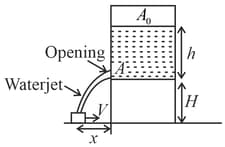EASY
Earn 100
What is steady and unsteady flow of fluid?
Important Questions on Mechanical Properties of Fluids
HARD
MEDIUM
HARD
MEDIUM
EASY
HARD
Consider the configuration of a stationary water tank of cross-section area and a small bucket as shown in figure below;

What should be the speed of the bucket, so that the water leaking out of a hole of cross-section area (as shown) from the water tank does not fall outside the bucket?
(Take, and ).
HARD
MEDIUM
What will be the nature of flow of water from a circular tap, when its flow rate increased from to The radius of the tap and viscosity of water are and , respectively. (Density of water : )
EASY
MEDIUM
HARD
The platelets are drifting with the blood flowing in a streamline flow through a horizontal artery as shown below:

Artery is contracted in region . Choose the correct statement.
EASY
MEDIUM
EASY
EASY
HARD
EASY
MEDIUM
EASY
EASY

